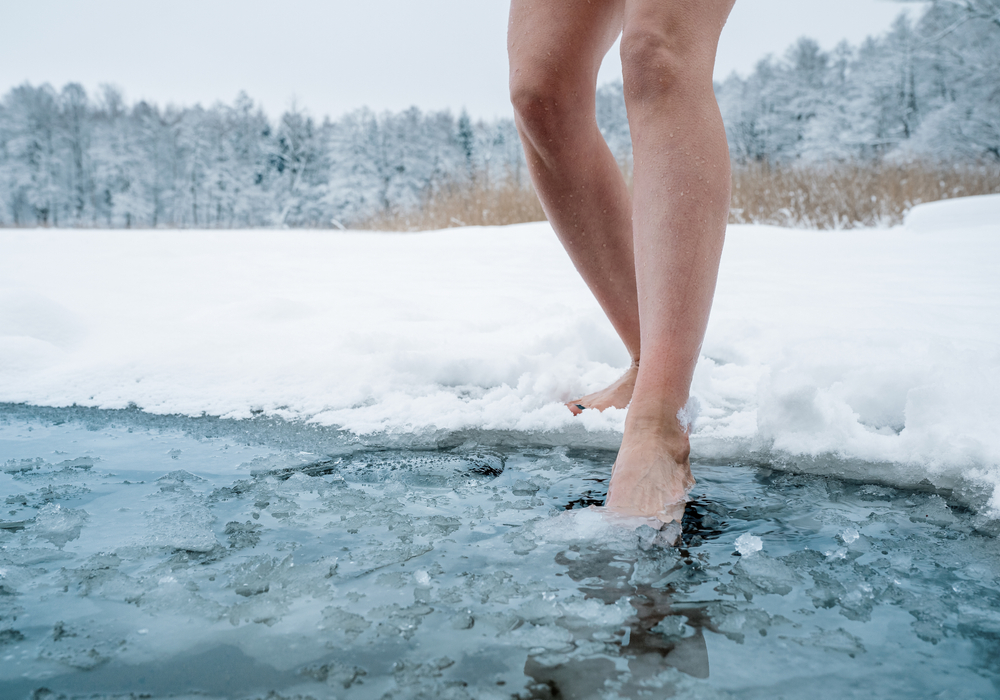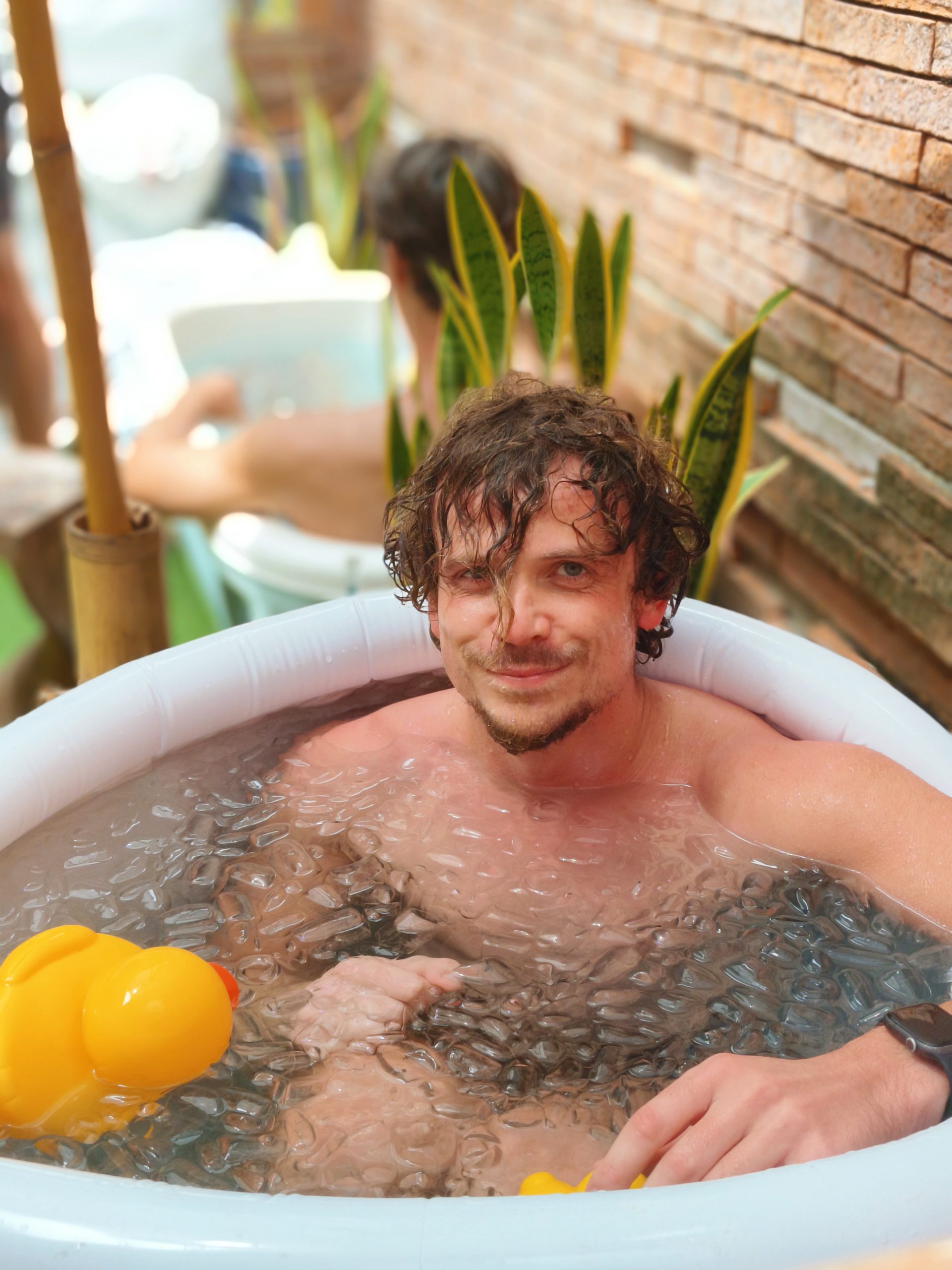The New Ice Age: cold exposure, ‘counting walls,’ and breaking through
By Ayush Madan
The first to humble me was the Pacific. I reluctantly placed both feet into the ocean, feeling a sharp, stinging pain radiating throughout the surface of my skin. The water temperature around Vancouver Island in January was a brisk 6ºC, made even colder by the strong currents and salinity. On the tails of my friend Michael, I waded in deeper, exposing more of my body to the unforgiving cold. When the water came up to my neck my teeth began chattering uncontrollably and I started to hyperventilate. Michael instructed me to breathe deeper, slower; to steady my mind and body.
With record-high temperatures in Thailand this year, any additional weapon to combat the heat is a welcome one. And while our oceans may be warm, it is quite easy to simulate the cold in a teak tub filled with water, ice, and salt. Last week, I had the pleasure of taking an ice bath on a rooftop in Thong Lo and left feeling energised and renewed by the experience. Civilizations as old as the Greeks believed that ice baths strengthened immunity, improved circulation, and enhanced mental acuity. But how does it all work?
Forcing yourself to remain in very cold water involves the prefrontal cortex – a part of the brain involved in planning and controlling impulses. By bearing the cold temperature of the water, people exert top-down control on the prefrontal cortex which builds endurance. Dr. Andrew Huberman, head of a neuroscience lab at the Stanford School of Medicine, recommends the counting walls approach for taking longer ice baths. Each time you feel the urge to leave the water, imagine a wall materializing in front of you. Next, imagine yourself breaking through this wall by resisting and overcoming the urge to get out of the bath. The more walls you count and break through, the stronger and more resilient you will become. This resilience built in the cold carries over to real-world stressors, allowing people who practice cold exposure to be better able to think, cope, and remain calm in overwhelming or stressful situations.
Moreover, exposing your body to extreme cold temperatures of 1-2℃ triggers the release of epinephrine and norepinephrine in the brain, neurotransmitters which regulate alertness and focus. While activities such as drinking a cup of coffee or a light jog can also trigger the release of these neurotransmitters, deliberate cold exposure elevates these levels significantly, increasing energy and concentration for hours following the plunge. Dopamine – the hormone which promotes goal-directed behaviour – increases by over 250% after cold therapy.
Furthermore, benefits gained from cold therapy extend beyond the mind into the body. Following cold exposure, the body burns calories to raise body temperature back to normal. This causes the conversion of white fat into brown fat. Unlike white fat, which is primarily for energy storage, brown fat is far more metabolically active which humans can burn to generate heat – the same mechanism bears use to stay warm during hibernation. While white fat has been associated with obesity and insulin resistance, brown fat improves metabolism and helps in weight management.
Importantly, athletes, sports enthusiasts, martial arts fighters, and marathon runners all benefit from ice baths, as they aid in post-exercise recovery, decreasing soreness and increasing muscle strength. Up to 5 minutes of cold-water immersion is all that is necessary to stimulate these benefits but waiting 6 to 8 hours after physical activity is ideal. Any sooner and the chilly water can limit gains in muscle hypertrophy and strength.
However, there are hazards to be aware of before jumping into an ice bath. Those with cardiovascular issues or high blood pressure should consult with their doctors about how the spike in heart rate could affect them. Additionally, pregnant women and those prone to panic attacks should refrain from cold therapy.
Bangkok is currently having a popularity boom in cold exposure therapy, as athletes and business executives alike embrace ice baths to manage stress and improve wellbeing. A community page on Instagram called @bangkokicebaths organizes weekly ice baths on Wednesdays, Saturdays, and Sundays at Kate’s Place in Thong Lo and Crusio in Phra Khanong. John and Beam the two organizers were friendly, supportive, and are keen on welcoming newcomers and initiating them in the ways of cold therapy.
A how-to guide to cold exposure (from Huberman Lab):
- 11 minutes per week TOTAL
- Aim for 2-4 sessions lasting 1-5 minutes distributed throughout the week
- The water temperature should be uncomfortably cold but safe enough to stay in
- For maximum benefits, start with the sauna, then the cold, then allow your body to dry naturally without a towel
Junaid Khan, Secondary School Teacher
Have you personally tried an ice bath? What was your experience like?
I’ve tried ice baths a couple of times. Initially, it’s a shock and very new sensation. But after learning to control your breathing, it becomes a much smoother experience.
Why do you think ice baths are becoming more popular?
Their increase in popularity is probably due to them become more easily accessible. Places like @bangkokicebaths hold events multiple times a week, which means people have more options.
What are some of the benefits you’ve perceived?
The main benefit I’ve perceived is the increase in dopamine. I usually feel happier and lighter for at least a few hours later. It also helps blood get deeper in my joints and helps with my recovery.
What are some risks to be aware of?
Most of the risks are related to a lack of preparation/awareness. You should mentally prepare yourself before entering an ice bath.
Patcharanun ‘Beams’ Pokinpatcharawat and John Cox, Founders of Bangkok Ice Baths
Why do you think ice baths are becoming more popular?
People are increasingly prioritising their health and well-being, and information on effective tools for optimising our health are more widely available and accessible thanks to podcasts. The enormously popular and influential The Joe Rogan Experience and respected and trusted The Huberman Lab podcasts have both talked extensively about the many benefits of ice baths.
Who are ice baths for?
I think for some people there’s a perception that ice baths are just for athletes or those with impressive beards. [Laughs] Whilst it is indeed great for muscle recovery, that’s not the only benefit. Whether you want to de-stress, lose weight, increase your willpower, or just want to feel amazing, ice baths offer a lot of benefits. Another common
misperception is that you have to breath in a certain way to do ice baths. I think breathwork like the one popularised by Wim Hof can be very beneficial, but you don’t have to do that to do ice baths.
What are some of the benefits people perceive after this experience?
Let’s start with how you feel. Taking an ice bath causes your brain to release a cocktail of chemicals like adrenaline, norepinephrine and dopamine that can make you feel energised, relaxed and a little high afterwards. This is one of the reasons why people come back again and again to take an ice bath. Secondly, ice baths can be a useful tool for helping you to regulate stress. Getting into an ice bath puts us in ‘fight or flight’ mode, and our natural impulse is to want to get out, but we can learn how to manage this stress with tools like deep breathing, which can ultimately improve our ability to deal with stress on a day-today basis. Thirdly, and for me this is the most important one, you get a powerful sense of accomplishment from doing something that makes you feel uncomfortable and that helps you overcome your
fears. This strengthens your will power or grit. You think to yourself, “If I can do this, what else can I do?”
What are some risks to be aware of?
Ice baths can be an intense experience, so anyone that’s unsure about their health condition should consult a doctor first. For healthy people, there are two main risks to extreme (0 degrees or below) and prolonged (more than 15 minutes) cold exposure: hypothermia and frostbite. I say extreme cold exposure because our ice baths don’t go colder than 4 degrees. At 4 degrees, there is a risk of hypothermia after 15 – 30 minutes, so to err on the side of caution, we limit people to a maximum of 10 minutes. In terms of frostbite, this is very unlikely since our ice baths are well above
freezing point.
On starting this community project:
We’ve been doing this for over two years, and it’s been a very gratifying experience. I think one of the reasons people keep coming back is that it’s a great way to meet like-minded people, and because we’re already out of our comfort zones it’s easier to connect with people and be vulnerable. Word is spreading that if you’re new to the city it’s a good place to quickly make friends, and then do other activities like bouldering. We’re excited to see this community continue to grow, and hope that some of your readership will be curious and want to come along!









